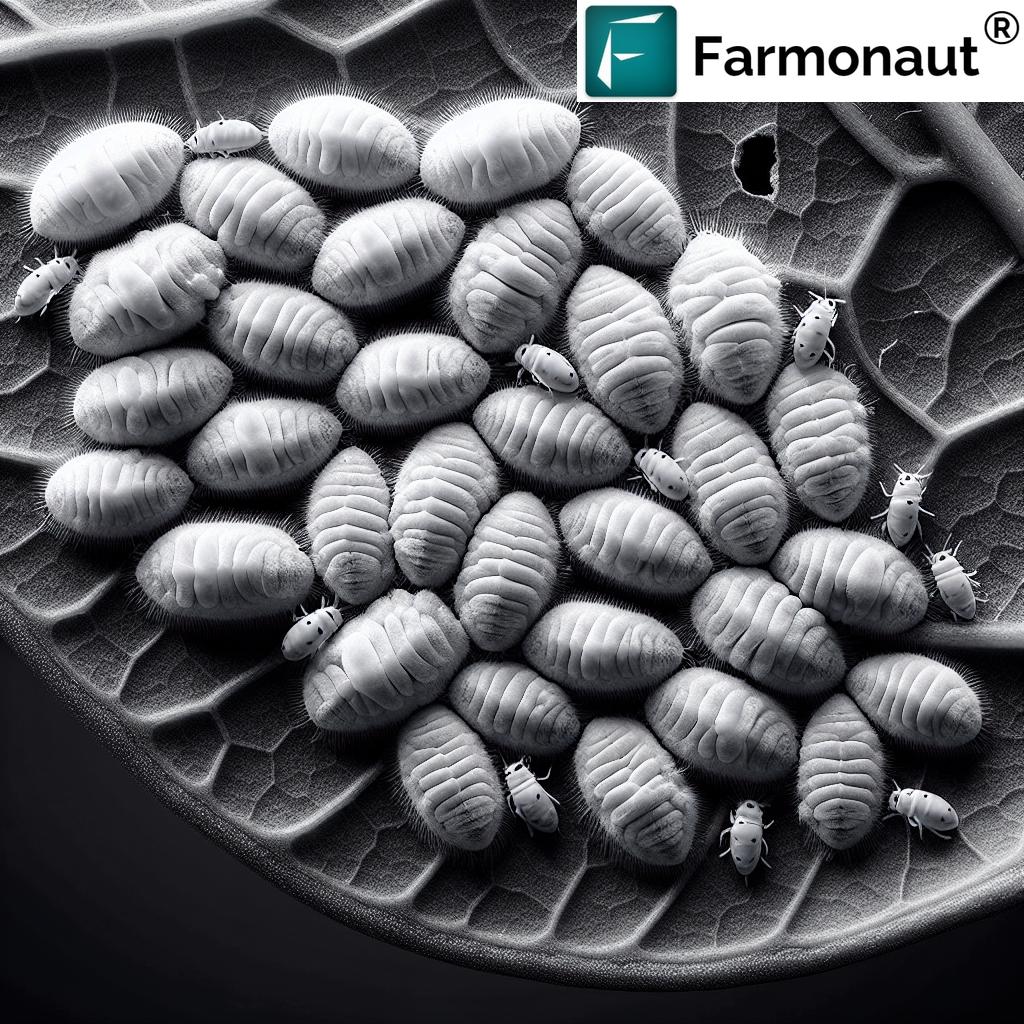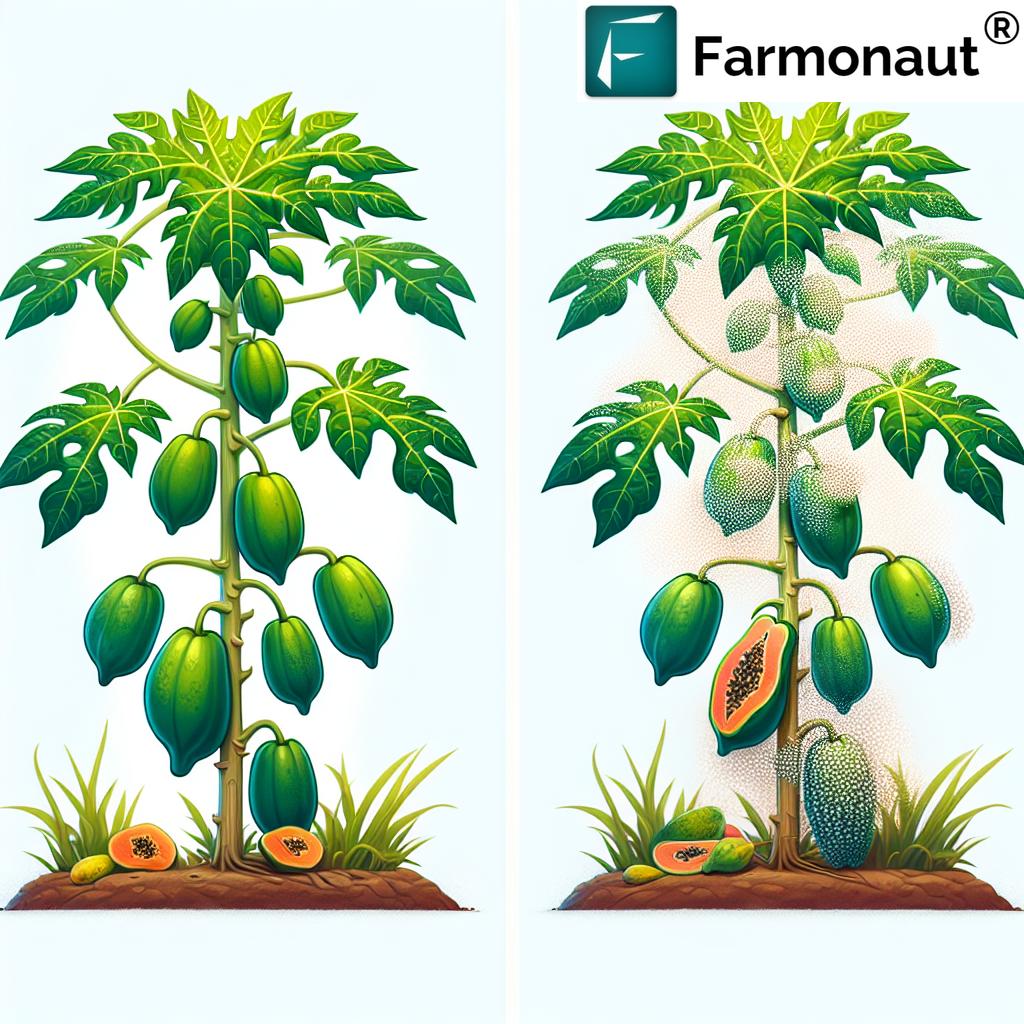Organic Mealybug Control: Protecting Citrus, Papaya, and Other Plants from Pest Infestations

At Farmonaut, we understand the challenges that farmers and gardeners face when it comes to protecting their crops from pests. One of the most persistent and damaging pests in agriculture is the mealybug. These small, soft-bodied insects can wreak havoc on a wide variety of plants, from citrus and papaya to grapevines and ornamentals. In this comprehensive guide, we’ll explore the world of mealybugs, their impact on crops, and most importantly, how to control them using organic methods.
Understanding Mealybugs: The Silent Destroyers
Mealybugs are small, soft-bodied insects belonging to the families Pseudococcidae and Putoidae. These pests are known for their distinctive white, waxy coating that gives them a mealy or powdery appearance. While they may seem harmless at first glance, mealybugs can cause significant damage to plants by sucking sap from leaves, stems, and fruit.
Key Characteristics of Mealybugs:
- Size: Generally 1-4 mm long
- Color: White or light gray due to waxy coating
- Shape: Oval or elongated
- Mobility: Slow-moving, often found in clusters
- Reproduction: Females can lay up to 600 eggs
Mealybugs are particularly problematic because they reproduce quickly and can infest a wide range of host plants. Some of the most commonly affected crops include:
- Citrus trees (oranges, lemons, limes)
- Papaya
- Apple trees
- Grapevines
- Peppers
- Eggplant
- Herbs like basil and mint
Identifying Mealybug Infestations: Symptoms and Signs
Early detection is crucial for effective mealybug control. As experts in agricultural technology, we at Farmonaut emphasize the importance of regular plant surveillance to catch infestations before they become severe. Here are some key symptoms and signs to watch for:
Visual Indicators:
- White, cottony masses on leaves, stems, and fruit
- Sticky residue (honeydew) on plant surfaces
- Sooty mold growth on leaves and branches
- Yellowing or wilting of leaves
- Stunted growth or deformed plant parts
Behavioral Signs:
- Increased ant activity around plants (ants are attracted to honeydew)
- Presence of natural predators like ladybugs or lacewings
It’s important to note that mealybug populations can explode rapidly under favorable conditions, making early detection and prompt treatment essential.
The Impact of Mealybugs on Crop Health and Yield
Mealybug infestations can have severe consequences for both commercial agriculture and home gardens. These pests not only damage plants directly but can also act as vectors for plant diseases. Let’s explore the various ways mealybugs can impact crop health and yield:
Direct Damage:
- Reduced photosynthesis due to leaf damage
- Stunted growth and weakened plants
- Premature leaf drop
- Fruit deformation and quality reduction
- Decreased yield and economic losses
Indirect Damage:
- Transmission of plant viruses
- Attraction of secondary pests (e.g., ants)
- Increased susceptibility to other diseases
- Reduced marketability of infested produce
For crops like citrus, papaya, and grapevines, mealybug infestations can lead to significant economic losses if left unchecked. This is why we at Farmonaut are committed to helping farmers implement effective pest management strategies using our advanced satellite-based monitoring system.
Organic Mealybug Control: A Sustainable Approach
At Farmonaut, we believe in promoting sustainable agricultural practices that protect both crops and the environment. When it comes to mealybug control, organic methods offer an effective and eco-friendly alternative to conventional chemical treatments. Here are some of the most effective organic strategies for managing mealybug populations:
1. Biological Control
Introducing natural predators is one of the most effective organic methods for controlling mealybugs. Some beneficial insects that feed on mealybugs include:
- Ladybugs (Cryptolaemus montrouzieri)
- Lacewings
- Parasitic wasps
These beneficial insects can be purchased from specialized suppliers and released into the affected area. They help keep mealybug populations in check without the need for chemical interventions.
2. Horticultural Oils
Neem oil and other horticultural oils are effective organic products for mealybug control. These oils work by smothering the insects and disrupting their life cycle. To use:
- Mix the oil according to package instructions
- Apply thoroughly to all plant surfaces, including undersides of leaves
- Repeat applications every 7-14 days as needed
3. Insecticidal Soaps
Organic insecticidal soaps are another effective treatment for mealybugs. These soaps break down the protective waxy coating of the insects, leading to dehydration. Application tips:
- Use a solution of 2-3 tablespoons of soap per gallon of water
- Spray directly on mealybugs, ensuring thorough coverage
- Reapply weekly until the infestation is under control
4. Pruning and Isolation
For localized infestations, pruning affected plant parts can be an effective control measure. Remember to:
- Remove and destroy heavily infested branches or leaves
- Isolate infested plants to prevent spread
- Clean pruning tools thoroughly between cuts to avoid spreading the pests
5. Natural Repellents
Certain plants and essential oils can help repel mealybugs. Consider:
- Planting marigolds or nasturtiums as companion plants
- Using garlic or chili pepper sprays as natural deterrents
- Applying diluted essential oils like peppermint or tea tree oil
The Role of Technology in Mealybug Surveillance and Control
At Farmonaut, we’re at the forefront of integrating technology into pest management strategies. Our satellite-based monitoring system offers several advantages for mealybug surveillance and control:
| Method | Accuracy | Coverage Area | Early Detection | Labor Intensity | Cost-Effectiveness |
|---|---|---|---|---|---|
| Visual Inspection | Moderate | Limited | Variable | High | Low |
| Sticky Traps | Moderate | Limited | Good | Moderate | Moderate |
| Pheromone Traps | High | Moderate | Excellent | Low | Moderate |
| Farmonaut Satellite System | Very High | Extensive | Excellent | Very Low | High |
As you can see, our satellite system offers unparalleled advantages in terms of coverage area, early detection, and cost-effectiveness. By utilizing advanced imaging technology and AI-driven analysis, we can help farmers detect mealybug infestations at their earliest stages, allowing for timely and targeted interventions.
Implementing an Integrated Pest Management (IPM) Approach
At Farmonaut, we advocate for an Integrated Pest Management (IPM) approach to mealybug control. This strategy combines various methods to achieve long-term, sustainable pest management. Here’s how to implement an effective IPM program for mealybugs:
1. Regular Monitoring
Use our satellite-based monitoring system to keep a close eye on your crops. Regular surveillance allows for early detection of mealybug populations before they reach damaging levels.
2. Cultural Practices
- Maintain proper plant spacing to improve air circulation
- Avoid over-fertilization, which can make plants more attractive to pests
- Remove and destroy infested plant material
- Use mulch to deter ants, which protect and spread mealybugs
3. Biological Control
Encourage or introduce natural predators as discussed earlier. Our satellite monitoring can help you identify areas where beneficial insects are most needed.
4. Organic Treatments
Apply organic insecticides and repellents as needed, based on the infestation level detected by our monitoring system.
5. Mechanical Control
For small infestations, manually remove mealybugs using a cotton swab dipped in rubbing alcohol.
6. Record Keeping
Maintain detailed records of pest populations, treatments applied, and their effectiveness. Our Farmonaut platform provides tools for easy data tracking and analysis.
Case Study: Successful Mealybug Control in Citrus Orchards
To illustrate the effectiveness of our integrated approach, let’s look at how a citrus orchard successfully managed a mealybug infestation using Farmonaut’s technology and organic control methods:
Background:
A 50-acre citrus orchard in California was experiencing recurring mealybug infestations, leading to reduced yield and fruit quality.
Implementation:
- The orchard owner subscribed to Farmonaut’s satellite monitoring service.
- Our system detected early signs of mealybug activity in specific sections of the orchard.
- Targeted release of ladybugs (Cryptolaemus montrouzieri) in affected areas.
- Application of neem oil spray on hotspots identified by satellite imagery.
- Implementation of improved cultural practices, including pruning and irrigation management.
Results:
- 80% reduction in mealybug populations within 3 months
- 15% increase in marketable fruit yield
- 50% reduction in chemical pesticide use
- Improved overall orchard health and biodiversity
This case study demonstrates how combining Farmonaut’s advanced monitoring technology with organic control methods can lead to significant improvements in pest management and crop productivity.
The Future of Mealybug Control: Emerging Technologies and Techniques
At Farmonaut, we’re always looking ahead to the latest innovations in pest management. Here are some exciting developments in mealybug control that we’re keeping an eye on:
1. RNA Interference (RNAi) Technology
This emerging technique involves using specific RNA molecules to silence genes in mealybugs, potentially disrupting their life cycle or feeding behavior.
2. Pheromone-Based Mating Disruption
Advanced pheromone formulations can confuse male mealybugs, preventing them from finding mates and reducing population growth.
3. Precision Agriculture and AI
Our Farmonaut platform is at the forefront of using AI and machine learning to predict pest outbreaks and optimize treatment timing.
4. Nanotechnology in Pest Control
Nanoparticles are being explored for their potential to enhance the efficacy and targeted delivery of organic pesticides.
5. Drone-Based Application Systems
Unmanned aerial vehicles (UAVs) could revolutionize the application of organic treatments, especially in large or hard-to-reach orchards.
As these technologies continue to develop, we at Farmonaut are committed to integrating the most effective and sustainable solutions into our pest management recommendations.
Frequently Asked Questions (FAQ)
Q1: How do mealybugs spread to new plants?
A: Mealybugs can spread through various means:
- Wind dispersal of young nymphs
- Transportation on infested plant material
- Movement of ants, which protect and transport mealybugs
- Contaminated gardening tools or clothing
Q2: Can mealybugs survive winter?
A: Yes, mealybugs can overwinter in protected areas such as bark crevices or soil. In warmer climates or greenhouses, they may remain active year-round.
Q3: Are there any plants resistant to mealybugs?
A: While no plant is completely immune, some are less susceptible to mealybug infestations. These include:
- Rosemary
- Lavender
- Thyme
- Oregano
Q4: How often should I apply organic treatments for mealybug control?
A: The frequency of application depends on the severity of the infestation and the specific product used. Generally, treatments should be applied every 7-14 days until the infestation is under control. Our Farmonaut monitoring system can help determine the optimal treatment schedule.
Q5: Can mealybugs infest indoor plants?
A: Yes, mealybugs can infest indoor plants. Regular inspection and prompt treatment are crucial for controlling indoor infestations.
Conclusion: A Holistic Approach to Mealybug Management
As we’ve explored throughout this comprehensive guide, effective mealybug control requires a multifaceted approach that combines advanced monitoring technology, organic treatments, and sustainable agricultural practices. At Farmonaut, we’re committed to empowering farmers and gardeners with the tools and knowledge they need to protect their crops from these persistent pests.
By leveraging our satellite-based monitoring system, implementing organic control methods, and staying informed about the latest developments in pest management, you can significantly reduce the impact of mealybugs on your plants. Remember, early detection and prompt action are key to successful pest control.
We invite you to explore how Farmonaut’s technology can revolutionize your approach to pest management. Visit our website or download our app to learn more about our services and start your journey towards more effective, sustainable farming practices.
Together, we can create a future where healthy crops and environmental stewardship go hand in hand.
Ready to take your pest management to the next level?
Subscribe to Farmonaut today and gain access to cutting-edge satellite monitoring and AI-driven insights for your farm:
For more information on our services and API access, visit:
- Farmonaut Web Application
- Farmonaut API
- Farmonaut Android App
- Farmonaut iOS App
- Farmonaut API Documentation
Join us in revolutionizing agriculture and pest management for a more sustainable future!







